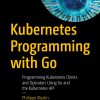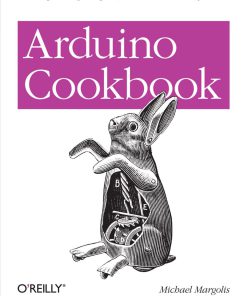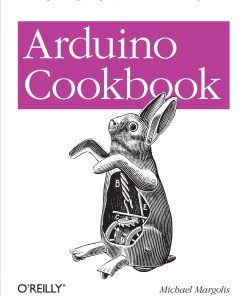Arduino Cookbook 1st editon by Margolis, Michael 1449313876 9781449313876
$50.00 Original price was: $50.00.$25.00Current price is: $25.00.
Arduino Cookbook 1st editon by Margolis, Michael – Ebook PDF Instant Download/Delivery: 1449313876, 9781449313876
Full download Arduino Cookbook 1st editon after payment

Product details:
ISBN 10: 1449313876
ISBN 13: 9781449313876
Author: Margolis, Michael
Want to create devices that interact with the physical world? This cookbook is perfect for anyone who wants to experiment with the popular Arduino microcontroller and programming environment. You’ll find more than 200 tips and techniques for building a variety of objects and prototypes such as toys, detectors, robots, and interactive clothing that can sense and respond to touch, sound, position, heat, and light.You don’t need to have mastered Arduino or programming to get started. Updated for the Arduino 1.0 release, the recipes in this second edition include practical examples and guidance to help you begin, expand, and enhance your projects right away—whether you’re an artist, designer, hobbyist, student, or engineer.Get up to speed on the Arduino board and essential software concepts quicklyLearn basic techniques for reading digital and analog signalsUse Arduino with a variety of popular input devices and sensorsDrive visual displays, generate sound, and control several types of motorsInteract with devices that use remote controls, including TVs and appliancesLearn techniques for handling time delays and time measurementApply advanced coding and memory handling techniques
Arduino Cookbook 1st Table of contents:
1. Getting Started
1.0. Introduction
1.1. Installing the Integrated Development Environment (IDE)
1.2. Setting Up the Arduino Board
1.3. Using the Integrated Development Environment (IDE) to Prepare an Arduino Sketch
1.4. Uploading and Running the Blink Sketch
1.5. Creating and Saving a Sketch
1.6. Using Arduino
2. Making the Sketch Do Your Bidding
2.0. Introduction
2.1. Structuring an Arduino Program
2.2. Using Simple Primitive Types (Variables)
2.3. Using Floating-Point Numbers
2.4. Working with Groups of Values
2.5. Using Arduino String Functionality
2.6. Using C Character Strings
2.7. Splitting Comma-Separated Text into Groups
2.8. Converting a Number to a String
2.9. Converting a String to a Number
2.10. Structuring Your Code into Functional Blocks
2.11. Returning More Than One Value from a Function
2.12. Taking Actions Based on Conditions
2.13. Repeating a Sequence of Statements
2.14. Repeating Statements with a Counter
2.15. Breaking Out of Loops
2.16. Taking a Variety of Actions Based on a Single Variable
2.17. Comparing Character and Numeric Values
2.18. Comparing Strings
2.19. Performing Logical Comparisons
2.20. Performing Bitwise Operations
2.21. Combining Operations and Assignment
3. Using Mathematical Operators
3.0. Introduction
3.1. Adding, Subtracting, Multiplying, and Dividing
3.2. Incrementing and Decrementing Values
3.3. Finding the Remainder After Dividing Two Values
3.4. Determining the Absolute Value
3.5. Constraining a Number to a Range of Values
3.6. Finding the Minimum or Maximum of Some Values
3.7. Raising a Number to a Power
3.8. Taking the Square Root
3.9. Rounding Floating-Point Numbers Up and Down
3.10. Using Trigonometric Functions
3.11. Generating Random Numbers
3.12. Setting and Reading Bits
3.13. Shifting Bits
3.14. Extracting High and Low Bytes in an int or long
3.15. Forming an int or long from High and Low Bytes
4. Serial Communications
4.0. Introduction
4.1. Sending Debug Information from Arduino to Your Computer
4.2. Sending Formatted Text and Numeric Data from Arduino
4.3. Receiving Serial Data in Arduino
4.4. Sending Multiple Text Fields from Arduino in a Single Message
4.5. Receiving Multiple Text Fields in a Single Message in Arduino
4.6. Sending Binary Data from Arduino
4.7. Receiving Binary Data from Arduino on a Computer
4.8. Sending Binary Values from Processing to Arduino
4.9. Sending the Value of Multiple Arduino Pins
4.10. How to Move the Mouse Cursor on a PC or Mac
4.11. Controlling Google Earth Using Arduino
4.12. Logging Arduino Data to a File on Your Computer
4.13. Sending Data to Two Serial Devices at the Same Time
4.14. Receiving Serial Data from Two Devices at the Same Time
4.15. Setting Up Processing on Your Computer to Send and Receive Serial Data
5. Simple Digital and Analog Input
5.0. Introduction
5.1. Using a Switch
5.2. Using a Switch Without External Resistors
5.3. Reliably Detecting the Closing of a Switch
5.4. Determining How Long a Switch Is Pressed
5.5. Reading a Keypad
5.6. Reading Analog Values
5.7. Changing the Range of Values
5.8. Reading More Than Six Analog Inputs
5.9. Displaying Voltages Up to 5V
5.10. Responding to Changes in Voltage
5.11. Measuring Voltages More Than 5V (Voltage Dividers)
6. Getting Input from Sensors
6.0. Introduction
6.1. Detecting Movement
6.2. Detecting Light
6.3. Detecting Motion (Integrating Passive Infrared Detectors)
6.4. Measuring Distance
6.5. Measuring Distance Accurately
6.6. Detecting Vibration
6.7. Detecting Sound
6.8. Measuring Temperature
6.9. Reading RFID Tags
6.10. Tracking Rotary Movement
6.11. Tracking the Movement of More Than One Rotary Encoder
6.12. Tracking Rotary Movement in a Busy Sketch
6.13. Using a Mouse
6.14. Getting Location from a GPS
6.15. Detecting Rotation Using a Gyroscope
6.16. Detecting Direction
6.17. Getting Input from a Game Control Pad (PlayStation)
6.18. Reading Acceleration
7. Visual Output
7.0. Introduction
7.1. Connecting and Using LEDs
7.2. Adjusting the Brightness of an LED
7.3. Driving High-Power LEDs
7.4. Adjusting the Color of an LED
7.5. Sequencing Multiple LEDs: Creating a Bar Graph
7.6. Sequencing Multiple LEDs: Making a Chase Sequence (Knight Rider)
7.7. Controlling an LED Matrix Using Multiplexing
7.8. Displaying Images on an LED Matrix
7.9. Controlling a Matrix of LEDs: Charlieplexing
7.10. Driving a 7-Segment LED Display
7.11. Driving Multidigit, 7-Segment LED Displays: Multiplexing
7.12. Driving Multidigit, 7-Segment LED Displays Using MAX7221 Shift Registers
7.13. Controlling an Array of LEDs by Using MAX72xx Shift Registers
7.14. Increasing the Number of Analog Outputs Using PWM Extender Chips (TLC5940)
7.15. Using an Analog Panel Meter as a Display
8. Physical Output
8.0. Introduction
8.1. Controlling the Position of a Servo
8.2. Controlling One or Two Servos with a Potentiometer or Sensor
8.3. Controlling the Speed of Continuous Rotation Servos
8.4. Controlling Servos Using Computer Commands
8.5. Driving a Brushless Motor (Using a Hobby Speed Controller)
8.6. Controlling Solenoids and Relays
8.7. Making an Object Vibrate
8.8. Driving a Brushed Motor Using a Transistor
8.9. Controlling the Direction of a Brushed Motor with an H-Bridge
8.10. Controlling the Direction and Speed of a Brushed Motor with an H-Bridge
8.11. Using Sensors to Control the Direction and Speed of Brushed Motors (L293 H-Bridge)
8.12. Driving a Bipolar Stepper Motor
8.13. Driving a Bipolar Stepper Motor (Using the EasyDriver Board)
8.14. Driving a Unipolar Stepper Motor (ULN2003A)
9. Audio Output
9.0. Introduction
9.1. Playing Tones
9.2. Playing a Simple Melody
9.3. Generating More Than One Simultaneous Tone
9.4. Generating Audio Tones and Fading an LED
9.5. Playing a WAV File
9.6. Controlling MIDI
9.7. Making an Audio Synthesizer
10. Remotely Controlling External Devices
10.0. Introduction
10.1. Responding to an Infrared Remote Control
10.2. Decoding Infrared Remote Control Signals
10.3. Imitating Remote Control Signals
10.4. Controlling a Digital Camera
10.5. Controlling AC Devices by Hacking a Remote-Controlled Switch
11. Using Displays
11.0. Introduction
11.1. Connecting and Using a Text LCD Display
11.2. Formatting Text
11.3. Turning the Cursor and Display On or Off
11.4. Scrolling Text
11.5. Displaying Special Symbols
11.6. Creating Custom Characters
11.7. Displaying Symbols Larger Than a Single Character
11.8. Displaying Pixels Smaller Than a Single Character
11.9. Connecting and Using a Graphical LCD Display
11.10. Creating Bitmaps for Use with a Graphical Display
11.11. Displaying Text on a TV
12. Using Time and Dates
12.0. Introduction
12.1. Creating Delays
12.2. Using millis to Determine Duration
12.3. More Precisely Measuring the Duration of a Pulse
12.4. Using Arduino as a Clock
12.5. Creating an Alarm to Periodically Call a Function
12.6. Using a Real-Time Clock
13. Communicating Using I2C and SPI
13.0. Introduction
13.1. Controlling an RGB LED Using the BlinkM Module
13.2. Using the Wii Nunchuck Accelerometer
13.3. Interfacing to an External Real-Time Clock
13.4. Adding External EEPROM Memory
13.5. Reading Temperature with a Digital Thermometer
13.6. Driving Four 7-Segment LEDs Using Only Two Wires
13.7. Integrating an I2C Port Expander
13.8. Driving Multidigit, 7-Segment Displays Using SPI
13.9. Communicating Between Two or More Arduino Boards
14. Wireless Communication
14.0. Introduction
14.1. Sending Messages Using Low-Cost Wireless Modules
14.2. Connecting Arduino to a ZigBee or 802.15.4 Network
14.3. Sending a Message to a Particular XBee
14.4. Sending Sensor Data Between XBees
14.5. Activating an Actuator Connected to an XBee
14.6. Sending Messages Using Low-Cost Transceivers
14.7. Communicating with Bluetooth Devices
15. Ethernet and Networking
15.0. Introduction
15.1. Setting Up the Ethernet Shield
15.2. Obtaining Your IP Address Automatically
15.3. Resolving Hostnames to IP Addresses (DNS)
15.4. Requesting Data from a Web Server
15.5. Requesting Data from a Web Server Using XML
15.6. Setting Up an Arduino to Be a Web Server
15.7. Handling Incoming Web Requests
15.8. Handling Incoming Requests for Specific Pages
15.9. Using HTML to Format Web Server Responses
15.10. Serving Web Pages Using Forms (POST)
15.11. Serving Web Pages Containing Large Amounts of Data
15.12. Sending Twitter Messages
15.13. Sending and Receiving Simple Messages (UDP)
15.14. Getting the Time from an Internet Time Server
15.15. Monitoring Pachube Feeds
15.16. Sending Information to Pachube
16. Using, Modifying, and Creating Libraries
16.0. Introduction
16.1. Using the Built-in Libraries
16.2. Installing Third-Party Libraries
16.3. Modifying a Library
16.4. Creating Your Own Library
16.5. Creating a Library That Uses Other Libraries
16.6. Updating Third-Party Libraries for Arduino 1.0
17. Advanced Coding and Memory Handling
17.0. Introduction
17.1. Understanding the Arduino Build Process
17.2. Determining the Amount of Free and Used RAM
17.3. Storing and Retrieving Numeric Values in Program Memory
17.4. Storing and Retrieving Strings in Program Memory
17.5. Using #define and const Instead of Integers
17.6. Using Conditional Compilations
18. Using the Controller Chip Hardware
18.0. Introduction
18.1. Storing Data in Permanent EEPROM Memory
18.2. Using Hardware Interrupts
18.3. Setting Timer Duration
18.4. Setting Timer Pulse Width and Duration
18.5. Creating a Pulse Generator
18.6. Changing a Timer’s PWM Frequency
18.7. Counting Pulses
18.8. Measuring Pulses More Accurately
18.9. Measuring Analog Values Quickly
18.10. Reducing Battery Drain
18.11. Setting Digital Pins Quickly
18.12. Uploading Sketches Using a Programmer
18.13. Replacing the Arduino Bootloader
18.14. Reprogram the Uno to Emulate a Native USB device
A. Electronic Components
A.1. Capacitor
A.2. Diode
A.3. Integrated Circuit
A.4. Keypad
A.5. LED
A.6. Motor (DC)
A.7. Optocoupler
A.8. Photocell (Photoresistor)
A.9. Piezo
A.10. Pot (Potentiometer)
A.11. Relay
A.12. Resistor
A.13. Solenoid
A.14. Speaker
A.15. Stepper Motor
A.16. Switch
A.17. Transistor
A.18. See Also
B. Using Schematic Diagrams and Data Sheets
B.1. How to Read a Data Sheet
B.2. Choosing and Using Transistors for Switching
C. Building and Connecting the Circuit
C.1. Using a Breadboard
C.2. Connecting and Using External Power Supplies and Batteries
C.3. Using Capacitors for Decoupling
C.4. Using Snubber Diodes with Inductive Loads
C.5. Working with AC Line Voltages
D. Tips on Troubleshooting Software Problems
D.1. Code That Won’t Compile
D.2. Code That Compiles but Does Not Work as Expected
E. Tips on Troubleshooting Hardware Problems
E.1. Still Stuck?
F. Digital and Analog Pins
G. ASCII and Extended Character Sets
H. Migrating to Arduino 1.0
Migrating Print Statements
Migrating Wire (I2C) Statements
Migrating Ethernet Statements
Migrating Libraries
New Stream Parsing Functions
People also search for Arduino Cookbook 1st :
arduino cookbook 3rd edition pdf
arduino cookbook 3rd edition
arduino cookbook
2 arduino serial communication
Tags:
Margolis,Michael,Arduino Cookbook
You may also like…
Computers - Computers - General & Miscellaneous
Computers - Programming
Engineering - Engineering - General & Miscellaneous
Engineering
Computers - Computer Science
Internet of Things with Arduino Cookbook 1st Edition Schwartz
Engineering
Uncategorized
Engineering











